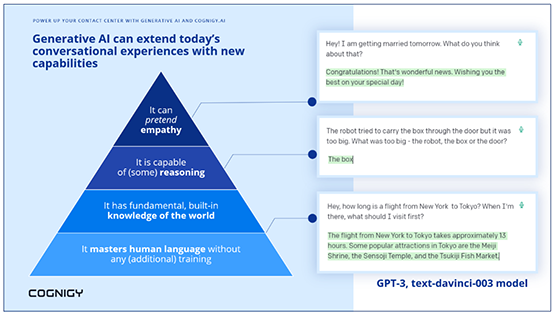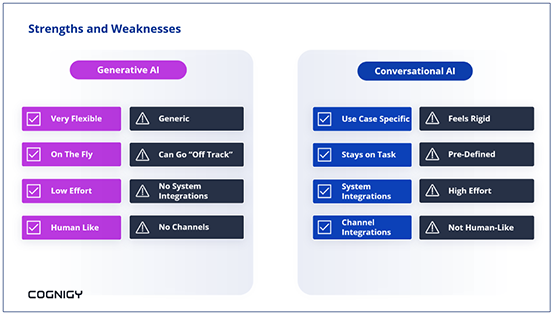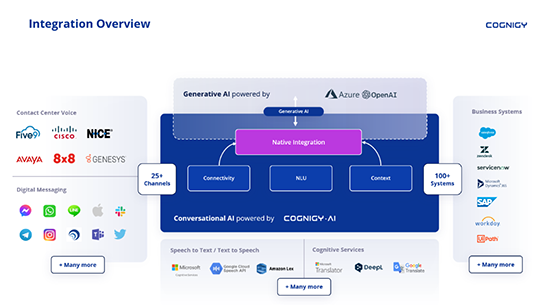OpenAI’s November 2022 announcement of a free research preview of ChatGPT to solicit user feedback took the tech world by storm. Before that, large language model (LLM) and generative AI were terms used primarily by technologists working in the field. Now, its use by one million users in just five days (as reported by Statista) has entered the online services history books, beating Instagram’s record of two-and-a-half months.
As was the case for many technologies before it, doomsayers were quick to say that this technology could replace humans in a host of different occupations. A New York tabloid article, "ChatGPT could make these jobs obsolete," pointed to positions in education, finance, software engineering, journalism and graphic design as being at risk.
The short answer to the question of whether generative AI will replace contact center agents is, at least for the foreseeable future, no. As outlined in a No Jitter article by Mila D'Antonio, “generative AI tools such as ChatGPT will show value in assisting or optimizing agents’ workloads and automating tasks rather than their jobs.”
There have been several press releases, blogs and social posts by customer experience vendors in the past month ( about plans to offer ChatGPT capabilities to their portfolios. As my editor will insist, I provide a sampling here:
- Avaya software developer Andrew Prokop has posted a series of videos on Linkedin, self-described as low-budget/no-budget voice-enabled ChatGPT applications.
- eGain Corporation announced the general availability of eGain Instant Answers™.
- A third-party developer on the Genesys Cloud platform posted a link to a chatbot integration demo.
- NICE announced ChatGPT-Enabled CXone.
I read each new announcement or social post eagerly but was left with a desire for a much deeper dive. How does each vendor intend to integrate their conversational AI portfolios with ChatGPT and bring the solutions to market? What are the particulars, both in technical decisions and in implementation?
Luckily, one vendor heard my virtual cry for more information and delivered. In late January, I was invited to attend a webinar, the Future of CX with Generative AI and Cognigy.AI. The three-part session included sections on:
- "Generative AI & the Contact Center," presented by Sebastian Glock, head of product marketing, Cognigy.
- A Cognigy.AI demo, "Generative AI in Action."
- A panel discussion with a managing director from Deloitte, Bjorn Bringmann, and Cognigy CEO and Co-Founder, Philipp Heltewig, moderated by Glock.
Glock did a masterful job of quickly providing a tutorial on the history of AI. He then left the bulk of his time for the meat of the matter – how ChatGPT can be used in the contact center, and specifically how it works with Cognigy.
Supporting customer service bots is one of the primary ways to use generative AI in the contact center. In addition to bringing information built on knowledge built from the internet, generative AI can add support for multiple languages, a level of reasoning, and methods for mimicking empathy – as shown in the graphic.
With all its strengths, generative AI has its weaknesses. The graphic below shows what Glock described as the strengths and weaknesses of generative AI compared to conversational AI. (Conversational AI is typically deployed in contact centers today.) His point was that the two technologies can complement each other. For example, while conversational AI can often require high effort to deploy, generative AI can reduce that effort. Similarly, today’s generative AI does not have integrations to the many systems used in contact centers today, e.g., CCaaS, CRM, and digital channels like messaging. Conversational AI systems like Cognigy and others can be used to supplement generative AI.
As seen in the graphic below, Cognigy.AI comes pre-integrated with more than 25 channels and 100+ pre-made backend integrations. It comes with a native integration to third party large language model (LLM) services such as Azure OpenAI to further enhance conversational experiences on voice and chat. The result combines the flexibility of generative AI with the enterprise-level building blocks of conversational AI.
While I have highlighted the chat and voice bot use cases of combining generative AI with conversational AI, the webinar also addressed how generative can be used for agent assistance, e.g., by answering questions, creating suggested answers, and summarizing customer interactions. In terms of helping companies more quickly develop and deploy bots, generative AI can be useful for generating training data and generating lexicons for applications, e.g., a list of US airport codes). Generative AI can even be used to build initial design flows for a new use case, e.g., changing a flight routing.
In terms of what this all means to the contact center technology decision manager, during the panel discussion Glock asked Deloitte’s Bringmann, “What can enterprises expect from a return on investment (ROI) perspective?”
“It depends on your baseline, where you start. There's already a lot a business can do moving from IVRs to customer service with chatbots,” Bringmann responded. “On top of that, you can use generative AI technology as a next step. And there's ROI in both steps. But you shouldn't necessarily jump to the most advanced version,” he concluded. Good advice.











